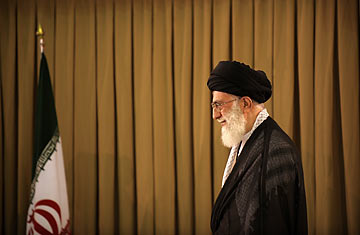
Iran's Supreme Leader Ayatullah Ali Khamenei
The fate of Iran's Islamic revolution now rests in the hands of an enigmatic cleric who is little understood at home, let alone by the outside world. For the past 20 years, pictures of Ayatullah Ali Khamenei, with his oversize glasses, black turban and untrimmed white beard, have adorned shops, government offices and living-room walls throughout Iran. His modest childhood home in Mashhad has become a virtual shrine, his edicts are binding and his powers absolute. Yet protesters forced from the streets this week have taken to shouting "Death to the dictator" and "Death to Khamenei" from their rooftops. Endowed with the infallible powers of a political pope, Iran's leader has suddenly discovered that his authority has also made him vulnerable.
Since June 19, Khamenei's controversial decision to dismiss all allegations of vote rigging and throw his weight behind President Mahmoud Ahmadinejad has produced the most serious challenge to his rule — and ultimately to the very concept of a Supreme Leader — since the 1979 revolution. Protesters have spurned his claim that foreign powers are behind the demonstrations, while opposition leader Mir-Hossein Mousavi continues to demand that the disputed election be annulled. Khamenei once again warned on June 24 that "neither the establishment nor the nation will yield to pressure at any cost." Demonstrations have abated under the unprecedented show of force by riot police and the paramilitary Basij vigilantes, but amid signs that the cost is a growing crisis of confidence in the Supreme Leader.
Despite his powers to overturn parliamentary laws, judicial decisions or presidential decrees, Khamenei has never been a very public figure, either as President between 1981 and 1989 or as Supreme Leader since then.
"There is perhaps no leader in the world more important to current world affairs but less known and understood than Ayatollah Ali Khamenei," writes Karim Sadjadpour in Reading Khamenei, a publication of the Carnegie Endowment for International Peace. "Neither a dictator nor a democrat — but with traits of both — Khamenei is the single most important individual in a highly factionalized, autocratic regime."
Khamenei first emerged in politics as the Islamic republic's third President in 1981, during a period of violent political turmoil that saw a President, a Prime Minister, 10 Cabinet officials and 27 members of parliament killed in massive bomb attacks. He was among the victims. He has walked with a cane, his right hand dangling uselessly at his side, ever since a small bomb inside a tape recorder went off as he was giving a Friday prayer sermon in 1981. He depends on aides or family to cut up his food.
Khamenei's election marked the consolidation of clerical control over the state. Revolutionary leader Imam Khomeini originally banned the clergy from running for the presidency, but as he lost confidence in squabbling technocrats, he urged his protégé to run for office. The result was Iran's first "government of God." Tensions with Mousavi, who at the time held the more powerful position, of Prime Minister, date back to this period. Throughout the 1980s, Khamenei and Mousavi clashed repeatedly on key political and economic issues.
It was also during those early years that Iran's political spectrum began to take shape. At one end were ideologues like Khamenei, who wanted Iran to play the role of a revolutionary "redeemer state," championing the cause of the world's downtrodden, pursuing Islamic political rule throughout the Muslim world and creating a new Islamic geopolitical bloc capable of challenging both East and West.
At the other end were realists and leftists, like Mousavi, who favored institutionalizing the revolution and creating a model Islamic government. Although they supported an Islamist political system and social order as well as independence from the great powers, they also called for a pragmatic foreign policy. The difference boiled down to whether the Islamic republic's top priority was the revolution or the state. That debate remains at the heart of the current crisis.
